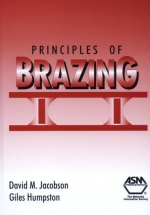Tab Article
Principles of Brazing is a valuable resource for those working with the brazing process or designing component joints. This book will help solve practical engineering challenges, by building on fundamental metallurgy. Precisely written, and well referenced, containing 200 figures and 56 tables, this book compares joining methods, explains the fundamental parameters of brazes, and surveys the metallurgy of braze alloy systems. The joining atmosphere, fluxes and fluxless brazing are investigated. The constraints that component metal and non-metal materials place on the brazing process are examined. A chapter is devoted to the direct brazing of non-metals. Jewelers will find the chapter on filler metals for gold and silver of interest.
The authors received valuable feedback from readers of their first book, Principles of Soldering and Brazing. The wide range of technical interests of these readers prompted the authors to expand the text into two companion volumes, one covering soldering and the other brazing. Similar to Principles of Soldering, published in 2004, this book provides brazing information in a readily accessible and easy to assimilate form. Priority is given to the fundamental principles that underlie this field of technology rather than recipes for making joints. The largely artificial distinctions between soldering and brazing are preserved because, despite their many commonalities, it has been found that practicing engineers are either concerned with soldering or brazing and seldom are involved with both simultaneously. Striking a balance between being unduly simplistic or overly mathematical in their approach, Humpston and Jacobson provide the critical analysis that is missing from much of the literature on brazing.


